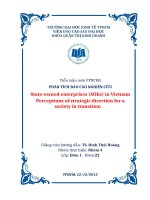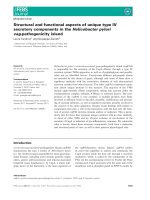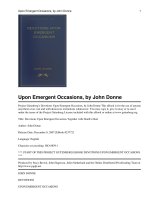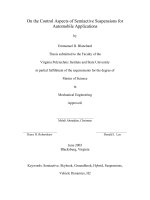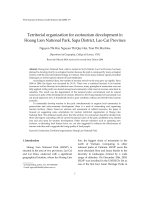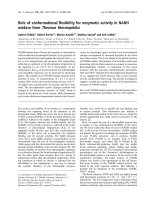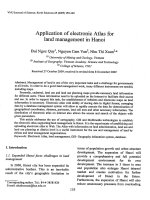Some aspects of environmental lease for ecottourism business in cat ba national park hai phong city vietnam
Bạn đang xem bản rút gọn của tài liệu. Xem và tải ngay bản đầy đủ của tài liệu tại đây (650.32 KB, 44 trang )
MINISTRY OF AGRICULTURE AND RURAL DEVELOPMENT
VIETNAM FORESTRY UNIVERSITY
STUDENT THESIS
SOME ASPECTS OF ENVIRONMENTAL LEASE FOR
ECOTOURISM BUSINESS IN CAT BA NATIONAL PARK,
HAI PHONG CITY, VIETNAM
Major: Natural Resources Management (Advanced Curriculum)
Code: D850101
Faculty: Forest Resources and Environmental Management
Student: Trieu Thi Hong Hanh
Student ID:1054030179
Class: K55 Natural Resources Management
Course: 2010 – 2014
Advanced Education Program
Developed in Collaboration with Colorado State University, USA
Supervisor: Assoc. Prof. Dr. Pham Van Dien
Hanoi, November 2014
Acknowledgements
Foremost, I would like to express my sincere gratitude to my supervisor Associate
Professor Dr. Pham Van Dien- Vice Rector of Vietnam Forestry University for the
continuous support of my study, for his patience, motivation, enthusiasm, and immense
knowledge. His guidance helped me in all the time of research and writing of this thesis.
Besides my supervisor, I would thank Cat Ba National Park management board,
some local people, businesses and particularly thanks to Mr. Nguyen Van Hach who is
via director of tourism service and environmental education center, Cat Ba National Park
for their encouragement, support, insightful comments, creating convenient conditions to
help me complete the study.
I must also acknowledge professors of Vietnam Forestry University and Colorado
State University, especially Pr. Lee MacDonald for taking time out from their busy
schedule to provide lectures, advice and guidance for my study.
A very special thanks goes out to my family for the support they provided me through my
entire life, without whose love and encouragement I would not have finished this thesis.
TABLE OF CONTENTS
ACKNOWLEDGEMENTS
TABLE OF CONTENTS
FIGURE
TABLE
PART I. INTRODUCTION ................................................................................................ 1
1.1. PROBLEM STATEMENT .......................................................................................... 1
1.2. OVERVIEW .................................................................................................................. 2
1.2.1. ABOUT ENVIRONMENTAL LEASE.................................................................... 2
1.2.2.
EXISTING
METHODS FOR DETERMINING THE PRICE OF
ENVIRONMENTAL LEASE ............................................................................................. 3
1.2.3. ENVIRONMENTAL LEASE IN THE PRACTICE .............................................. 5
1.2.4. GAPS AND SHORTCOMINGS............................................................................... 7
1.3. OBJECTIVES ............................................................................................................... 8
PART II. SITE DESCRIPTION......................................................................................... 9
2.1. GEOGRAPHIC LOCATION AND RESOURCE VALUES .................................... 9
2.2. GENERAL INFORMATION ABOUT ECOTOURISM ACTIVITIES IN CAT
BA NATIONAL PARK ..................................................................................................... 11
2.3. THE ADVANTAGES, POTENTIALS AND LIMITATIONS OF ECOTOURISM
DEVELOPMENT .............................................................................................................. 12
PART III. METHODS .................................................................................................... 13
3.1. DATA APPROACH ................................................................................................... 13
3.2. DATA COLLECTION ............................................................................................... 13
3.3. DATA ANANYSIS ...................................................................................................... 14
PART IV. RESULTS AND DISCUSSTION ................................................................... 17
4.1. CURRENT STATUS OF ENVIRONMENTAL LEASE LOCATIONS AND
ORIENTATIONS FOR ECOTOURISM ACTIVITIES................................................ 17
4.2.
COMPETITIVE
ADVANTAGES
OF
ENVIRONMENTAL
LEASE
LOCATIONS ..................................................................................................................... 20
4.3. ENVIRONMENTAL LEASE PRICE UNIT AND AMOUNT OF MONEY ........ 24
4.4. CLASSIFICATION OF ENVIRONMENTAL LEASE LOCATIONS BY
AMOUNT OF MONEY FOR LEASE ............................................................................. 29
4.5. IMPLICATIONS ........................................................................................................ 30
PART V. CONCLUSIONS AND RECOMMENDATIONS .......................................... 31
5.1.CONCLUSIONS .......................................................................................................... 31
5.2.RECOMMENDATIONS............................................................................................. 32
REFERENCES
APPENDIX
FIGURES
FIGURE 2.1. GEOGRAPHIC LOCATION OF CAT BA NATIONAL PARK ............ 9
FIGURE 4.1 . MAP OF ENVIRONMENTAL LEASE LOCATIONS IN CAT BA
NATIONAL PARK............................................................................................................ 17
TABLES
TABLE 1.1: THE FOREST LEASE OBJECTS ACCORDING TO LAW ON
FOREST PROTECTION AND DEVELOPMENT 2004................................................. 3
TABLE 1.2. METHOD FOR DETERMINING THE PRICE OF FOREST TYPES .. 4
TABLE 4.1: ENVIRONMENTAL LEASE LOCATIONS AND AREA IN CAT BA
NATIONAL PARK............................................................................................................ 18
TABLE
4.2. COMPETITIVE ADVANTAGES OF ENVIRONMENTAL LEASE
LOCATIONS ..................................................................................................................... 21
TABLE 4.3: PARAMETERS AND CRITERIA TO ASSESS REGRESSION MODEL
BETWEEN G AND INFLUENCING FACTORS .......................................................... 24
TABLE
4.4: ENVIRONMENTAL LEASE PRICE UNIT AND AMOUNT OF
MONEY .............................................................................................................................. 25
TABLE
4.5: ENVIRONMENTAL LEASE PRICE UNIT AND AMOUNT OF
MONEY THAT PROPOSE PEOPLE'S COMMITTEE OF HAI PHONG CITY
APPROVES. ....................................................................................................................... 26
TABLE 4.6: COMPARISON BETWEEN THE AMOUNT OF MONEY FOR
ALLOCATION AND THE AMOUNT OF MONEY FOR ENVIRONMENTAL
LEASE IN 10 LOCATIONS ............................................................................................. 28
TABLE 4.7: 22 LOCATIONS CLUSTERING BY AMOUNT OF MONEY FOR
ENVIRONMENTAL LEASE ........................................................................................... 29
Part I. Introduction
1.1. Problem statement
Environmental service development is a promising orientation to link conservation
with developing and enhancing the value of ecosystems. Nowadays, environmental service
is a factor to regulate relationships and share interests between stakeholders; in which
forest and marine environmental lease activities for ecotourism business are concerned in
many places, particularly in special use forests such as Cat Ba National Park.
Cat Ba National Park has a rich, attractive and unique ecotourism resource with the
harmony of the natural scenes as: forests and sea, mountains and caves, canyon lands and
valleys, limestone islands and slough, tides and corals, golden sunlight and sands, Cat Ba
langur, Nageia fleuryi populations and lakes in the mountains…Cat Ba National Park is
also located in the focal economic triangle area of the North: Hanoi- Hai Phong- Quang
Ninh, and it belongs to the Ha Long bay- World Natural Heritage area. With these
attractions and advantages, ecotourism provides the opportunity of high economic
efficiency and becomes a factor that conserves the environment of Cat Ba National Park.
However, ecotourism activities in Cat Ba National Park are having difficulties and
many shortcomings, namely:
- Great potential of developing ecotourism but now the contribution of ecotourism in
revenues of Cat Ba National Park is just 1 billion Vnd/year. Ecotourism service is poor,
simple and does not meet the demands and satisfaction of tourists. Surreptitious
exploitation of ecotourism resources of local people and businesses to have profits is as
well occurring.
- Lack of resources to meet the ecotourism demand. By decision No 2119/QĐUBND on 04/12/2012 of Hai Phong People’s Committees decided about the scheme for
ecotourism development in Cat Ba National Park [17]; need for capital source up to 2020
is very large (>300 billions Vnd), the state budget is not able to come up for these costs.
1
- No suitable mechanisms or policies in attracting businesses and private companies that
invest in environmental lease, such as: undetermined lease size, lease period, severity of the
impacts and responsibility to protect, embellish environment and landscape; especially is not
determined the price of environmental lease as well as the payment method between the
parties. This limitation is one of the reasons that makes “socialization” level on forest
environmental service payment in Cat Ba National Park slow and less efficient.
To contribute to solving the above mentioned shortcomings, the study “Some aspects
of environmental lease for ecotourism business in Cat Ba National Park, Hai Phong city,
Vietnam” has been compiled to clearly determine the location, price to lease and some
implications of the study.
1.2. Overview
1.2.1. About environmental lease
Around the world, the concept of environmental service payment is understood as
follows: "a voluntary transaction for a specific environmental service .... between at least
one party to use environmental service and a party that provides environmental service if
and only if the party that supplys environmental service has capable of providing the
service (in specific conditions) (Wunder, 2005). [21]
In Vietnam, there are only concepts about forest environmental services payment are
used and institutionalized. Until now, there is not a legal framework about environmental
service payment for all environmental services without forest environmental services. In
Vietnam, the concept of environmental service payment is explained different from the
international under some angles as follows: First, the government plays a major regulatory
role: environmental service payment is considered as a instrument based on market,
compulsory to apply for a certain number of conditions are put into the provisions of the
Government. Secondly, poverty reduction is one of the main objectives of policies about
environmental service payment .
2
At the Nature Reserve, environmental service payment is offered by Management Board,
especially with the support from local communities or individuals. The party that use service are
businesses with revenues from tourism service and tourists visiting the protected area.
1.2.2. Existing methods for determining the price of environmental lease
- Law on Forest Protection and Development (2004) [10] has established two fundamental
rights for forest owners to engage in forest lease- for lease relations, namely in Table 1.1:
Table 1.1: The forest lease objects according to Law on Forest Protection and
Development 2004
Forest lease
Kinds of lease
objects
forest
Payment
Lease purposes
of lease
Forest protection and development
combined forestry- agriculture- fishery
Annual
productions, landscape business,
payment
Protection forests.
1. Economic
ecotourism.
organizations.
Special-use forests
Forest protection and development
are protected
combined landscape business,
Annual
landscape areas.
ecotourism.
payment
2. Domestic
Forestry production, combined forestry-
economic
agriculture- fishery productions,
Annual
landscape- convalescence business,
payment
organizations,
Production forests.
households,
ecotourism.
individuals.
3.The Vietnamese
Implementation of investment projects
settled in abroad,
Production forests
in forestry under the provisions of the
oversea
are planted forests.
Law on investment, combined forestry -
3
Pay once
for the
organizations,
agriculture – fishery productions,
entire
foreign
landscape- convalescence business,
lease
individuals.
ecotourism.
period or
Annual
payment
Production forests
Government regulations
are natural forests.
- Decree No.48/2007/NDD-CP of the Government dated on 28/03/2007 [11] about the
principles and methods of determining the price of forest types, has launched three methods to
determine the price to use forests (protection forests, special use forests, production forests are
natural forests), forest ownership price (production forests are artificial forests):
Table 1.2. Method for determining the price of forest types
Method for
Content
Conditions to apply
determining the price
- Pure income
There is enough information to
- Interest rates of
determine the pure income of forest
government bonds.
owners from the forest area that
1. Income
required a determining the price .
2. Cost
- The investment costs of
There is enough information to
forest creation.
determine the investment costs to
- The interest rate of
“create” forests for forest area under
government bonds at the
valuation from invest moment to
time of valuation.
valuation moment.
3. Comparison of the
market
Analysis price level
4
- “ Willingness to pay” method: “ Ecosystem service valuation and Payment
mechanisms applied to Cat Ba National Park” report (Dominic Moran and Institute of
Forestry Ecology and Environment, 10/2012) [1] and the secondary report “Ecotourism
value quantifying in Cat Ba National Park by using Contingent valuation method” (Do
Nam Thang & Dinh Duc Truong, 2013) [2] all assessed the value of ecosystem services in
Cat Ba National Park by “ Willingness to pay” method . The first report assessed value of
Cat Ba National Park on the basis of “Willingness to pay” level of tourists. “Willingness to
pay” level in 2012 was 0.57 million USD (≈11.4 billion Vnd), and up to 2018, this level
will increase is 0.76- 1.01 million USD (≈15.2-20.2 billion Vnd). The second report
assessed the total of “Willingness to pay” level for environmental lease of local people
who live near Cat Ba National Park; and “Willingness to pay” level of them to Cat Ba
National Park is 32 billions Vnd/ year. Thus, by those reports, actual revenue from
ecotourism of Cat Ba National Park today is much less than current potential revenue. This
is a method that I can use to determine the price of leasing environment. This is useful in
cases when price is not known. This method tries to determine the price that people are
willing to pay for this lease. “Willingness to pay” is also the maximum amount that an
individual or business is willing to sacrifice to lease environment. The price of any
transaction will thus be any point between a buyer’s willingness to pay and a seller’s
willingness to accept.
1.2.3. Environmental lease in the practice
In 2002, Ba Vi National Park piloted in forest environmental lease to develop
ecotourism (According to Document No.1248/CP-NN dated on 10/09/2002 of the
Government on approving the project "Piloting in using of special-use forest environment
for service business and vocational guidance education in Ba Vi National Park " [12];
Decision No. 5561/QD-BNN-KL on 09/12/2002 of the Minister of Agriculture and Rural
Development approving scheme about Piloting in using of special-use forest environment
5
for ecotorism development and vocational guidance education in Ba Vi National Park” [15]).
The summary model in Ba Vi showed that the forest areas that are leased by businesses for
ecotourism are well protected. The area which affect forests to build tourism infrastructure
accounted for a small proportion compared with the lease area.Some poor forest areas that
have been cleared previously are restored, landscapes at some lease locations are
embellished in order to attract tourists; businesses that use forest environmental lease for
ecotourism planted 51.6 hectares of new forest, nurtured and grew additional 119.7 hectares.
Durin g the period of 2004 - 2009, these businesses invested 250 billion VND; contributed to
the State budget taxes, charges are 17 billion VND. According to the People's Committee of
Ba Vi district, only 6 forest environmental lease units attracted and created stable jobs for
1,576 local people. Many traditional handicraftmanships are restored, developed; maintained,
promotion of indigenous culture and progressive manufacturing experiences are also shared
through the exchange activities. The investment of districts and province in infrastructure and
services business activities of ecotourism zones created the basic conditions for changing the
socio-economic aspects of rural mountain area. The proportion of poor households in Ba Vi
district decreased from 25.3% in 2003 to only 9.7% in 2007, so that local people do not have to
suffer hunger. Our study shows that almost all of the forest environmental lease zones for ecotourism are the central areas which have beautiful natural scenery with historical monuments.
Type of ecotourism in here is the sightseeing services. The price of forest environmental lease
is different in each area, in the centers they are higher than in the outlying areas. So the pilot
model of forest environmental lease for ecotourism in Ba Vi National Park is a good model
that should be replicated.
Many provinces have piloted forest environmental lease models for ecotourism
development as Thanh Hoa, Lam Dong, An Giang, Ba Vi – Ha noi ... Quang Ninh
Province identified the unit price for land lease and price for water surface lease on the
basis of Decree No.142/2005/ND-CP of the Government dated on 14/11/2005 [13] and
6
Circular 120/2005/TT-BTC on 30/12/2005 of the Ministry of Finance [16] guiding the
implementation of Decree 142/2005/ND-CP on 14/11/2005 of the Government; Can Tho
city applied the ratio to calculate the unit price for water surface lease to build jetties,
anchoring wharves is 1% of non-agricultural land price.
Ecotourism in Cat Ba National Park has been assigned to the Travel Service and
Environmental Education Center for direct management since 2009. The center plays a key
role in collecting visitor fees and guiding tourists. The principal activities of ecotourism in
Cat Ba National Park are: a) Organize sightseeing tours of natural landscape, biodiversity ;
b) The operation of hotels, restaurants and entertainment venues.
Based on the pilot model, Cat Ba National Park initially piloted for allowing
businesses and other entities that play an important role in supplying the ecotourism needs
of tourists through forest environmental lease form from the past few years. There are 10
places that have been allocated to the private and businesses with a total revenue of 280
millionVnd (2013). This money also helps for the park management, protection of forest,
and regulation of human resource to other areas. If we continue to attract private and
businesses to lease environment for ecotourism, we will contribute to a better
implementation of conservation goals associated with development and connection in
resource management.
Ecotourism development scheme in Cat Ba National Park was approved by the Hai
Phong city People's Committee, which provided clearly locations, types and organizations
for management of ecotourism activities, especially environmental lease locations.
1.2.4. Gaps and shortcomings
Until now, the environmental lease for ecotourism development in Cat Ba National
Park has not been carried out strictly in all years. Activities are just “allocated locations”
for private or businesses under the condition that people who are allocated must pay the
annual costs. In 2013, there are 10 locations that were allocated with a total area of 148 ha
7
(in that water surface area accounts for over 60%), the total collected amount is 280
million Vnd. However, this allocation is also considered the first successful step in
environmental lease in the local area.
Nevertheless, allocated activities for ecotourism development in Cat Ba National
Park also have many disadvantages:
The allocated price is only based on the agreement between the two parties, has
not been calculated in detail and in general, it does not approach the market price.
The time limit for allotment is unclear, not high legality, so the investment of
businesses is very limited. That affects not only attraction to tourists but also service quality.
Lack of evaluation and supervision about the forest resources management and
biodiversity protection in allocated activities.
These problems posed requirements about transforming activities from "location
allotment " to " environmental lease" for ecotourism development completely with a full
range of scientific bases and in accordance with the practice here.
1.3. Objectives
In order to contribute to solve these shortcomings, this study will investigate some
of these aspects of environmental lease for ecotourism business in Cat Ba National Park,
Hai Phong city, Vietnam. The specific objectives are:
To determine the location, price of environmental lease for ecotourism business
at 22 places in Cat Ba National Park.
To predict the price of environmental lease for any place in the study area based
on results from determining the price of environmental lease for ecotourism business at 22
places in Cat Ba National Park.
To find out some implications of the study.
Contribute to provide some data and information relating to environmental lease.
Creat opportunity to Cat Ba National Park links with local businesses.
8
Part II. Site description
2.1. Geographic location and resource values
Cat Ba National Park, Hai Phong City, was established by Decision No.79/CT March
31, 1986 of the President of the Council of Ministers (now Prime Minister). The park was
officially approved by Technical and Economic Justification dated on 01/08/1991 by
Decision No. 237/CT of the Council of Ministers.
Figure 2.1. Geographic location of Cat Ba National Park
Cat Ba National Park is at 20°44' - 20°52' North latitude and 106°59'- 107°06' East
longitude, about 150 km southeast from Hanoi. Cat Ba is the gateway of Hai Phong city
and a center of biodiversity, geology, natural scenery, tourist of the city.
The land area of Cat Ba National Park is 16,196.8 ha, with island area of 10,931.7 ha
and the sea area of 5,265.1 ha . The park is divided into three functional zones: Strict
9
protection zone: 4,914.6 ha; Ecological restoration zone: 11,094 ha; Administration and
service zone: 93.1 ha.
* About landscape, environment, conservation and ecotourism values
The sea is one of the most important tourism potential of Cat Ba. Beaches system
(about 20 beaches can exploit) is not large but nice, clear blue sea, white sands have
attracted many tourists to travel and sea bath in the hot summer. Besides, the potential of
interesting tourism kinds as scuba diving, watching corals and marine life through the clear
waters, kayark rowing, fishing, ... In addition, the sea plays an important role in connecting
Cat Ba with Ha Long Bay that creates ability to lasting travel tours and product
diversification.
Unique limestone islands system: Cat Ba archipelago, outside the main island there
are 366 small islands with their own shapes that create a very attractive, unique landscape
as a miniature of Ha Long bay. Typical as Lan Ha Bay, Viet Hai Gulf, Van Boi, etc Many
islands have strange shapes, coral shelves, and on the islands there are salty lakes- there is
an unexplored potential.
Interesting caves system: According to geologists, Cat Ba archipelago was formed by
tectonic movement of the earth's crust and sea level raised and lowered millions of years
ago. It has karst terrain (limestone), with lots of interesting caves as the Qua Vang, Thien
Long, Trung Trang, Vem,Tien Duc... and beautiful beaches as Cat Co, Cat Dua, Ba Trai
Dao, Van Boi, etc Many places are primitive that are covered by green trees in a charming
scenery with sea and mountains as Vem cave, Tien Duc cave, etc. Now, there are over 10
caves assigned to the use for tourism.
Stream and lake systems: Cat Ba National Park has a famous stream system known
as: Thuong Luong (Tran Chau commune), Trung Trang, Treo Com ( Dong Co area). There
are natural lakes in limestones (frog pond), an area of over 3.6 hectares, with water all year
reaching a water level of around 30 cm, located among primary forest area.
10
About cultural tourism potential, Cat Ba is the area of the oldest settlement of
residents. Over time, the interaction between nature and man have created the unique
cultural characteristics related to human life here. There are many cultural, history and
archeology monuments in the park and in Cat Ba Island as Cai Beo relic, Hien Hao temple,
Quan Y cave, Uy Ban cave, Huyen Uy cave.Traditional culture life and festivals bring
many unique identities, characterized by fishermens with aquaculture and fishing along
with interesting games, unique rituals to hope Long Hai Dai Vuong- god of the sea will
bless for a seafood bumper year. Every year, local people hold dragon boat race on the sea
2.2. General information about ecotourism activities in Cat Ba National Park
Cat Ba National Park is the full convergence of strict criteria of ecotourism. The
stunning beauty and pristine ecosystems, the majestic beauty of the natural landscape, the
richness and diversity of biodiversity resources has brought fame to Cat Ba National Park.
However, at the moment ecotourism activities of Cat Ba National Park are limited to
organization of some sightseeing tours.
Tourism activities began to develop in Cat Ba Island in the 1990s. Cat Ba is a
destination with a constantly increasing number of international and domestic tourists.
According to source of Cat Ba National Park (2013), the number of tourists increased from
45,182 visitors in 2003 to 144,194 visitors in 2013 ( increased by 3.2 times). This also
shows that the sea tourism routes attract more tourists to visit than the forest routes ( by
2.25 times). Therefore, it is necessary to consider this factor in determining the price unit
of environmental lease for ecotourism business at each specific location.(*)
An important detail is that revenues from ecotourism activities are low, they only
reached 1.946 billionVnd in 2013 (accounted for 4.8% of the revenues of the park). In
particular, revenues from allocating locations for ecotourism were just 280 millionVnd in
2013, equivalent to 14.3% compared with revenues from ecotourism. (**)
11
Results of the survey (in 2014) show that an increase of the number of visitors to Cat
Ba island is quite high, the average is 30% / year. However, there are two problems in this
process: (i) The increase is mainly due to the chain effect of Ha Long Bay tourism system ;
(ii) The growth rate is not stable between years. This indicates that the environmental lease
for ecotourism development is necessary and contributes to attract tourists on the basis of
natural resources conservation, while improving the contribution of service business
activities to develop ecotourism.
2.3. The advantages, potentials and limitations of ecotourism development
- The advantages, potentials: Cat Ba archipelago is a masterpiece of nature at the
beginning of the country. It has unique natural landscape, special forest- marine
ecosystems, typical biodiversity resources. Cat Ba has population density and poverty rate
are relatively low. Economic- social and cultural environment in the islands is stable,
which creates many advantages and a great potential for ecotourism development.
- The limitations: Services related to ecotourism in Cat Ba have not yet been
developed and do not contribute significantly to meet the needs of the visitors. Poor
infrastructure also significantly affects the quality of ecotourism activities. The
organization of ecotourism is not synchronized and low professionalism is a major limiting
factor to ecotourism development in Cat Ba National Park. One of the causes for this
situation in terms of limitation of state investment sources is the fuzzy level of
socialization of ecotourism, resources of businesses, private and other economic sectors
have not been mobilized to develop ecotourism.
12
Part III. Methods
3.1. Data approach
Environmental lease area includes land area and sea surface area. Investors are
required to carry out construction engineering works under the provisions of the State; as
well they will be responsible for resources protection, and fire prevention and fighting all
over the assigned area.
Based on natural and socio-economic conditions, the importance of each location and
the extent of impacts, targets shall be set up in order to determine indexes to identify the
price for each area by using fuzzy math, such as “fuzzy regression”. Detail in the following
section.
3.2. Data collection
Due to different characteristics, advantages and limitations of the lease places, the
exploitation of the places will be at different impact levels, environmental lease price has
to be calculated for each place.
In order to determine the environmental lease price assigned to each place, my thesis
clearly describes the purposes and development orientations for each place. I will
investigate 22 places in Cat Ba National Park. In each place, I have 10 outforms for 10
people (including some Cat Ba National Park staffs, local peple and businesses) that I
investigated 7 parameters, of which 6 parameters – namely Land area of each location
(size of the lease area); Attraction level to tourists; Service diversification level;
Convenience level, conditions for reducing transport costs; Connection level with other
tourism places and Level of investment attraction for businesses and private – reflect the
characteristics, potential, and advantages of the lease area and 1 parameter reflects the
“willingness to pay” level for environmental lease to develop ecotourism. The 7th factor is
classified as subjective factor being related to the purpose of socialization, management
13
conditions and environmental lease priorities of Cat Ba National Park in the conservation
of forest resources and biodiversity. This factor is evaluated in three levels (level 1 - low
priority, level 2 - medium priority, level 3 - high priority). Thus, there are 7 factors that
control the environment lease price. Besides, 8th factor is the price unit or environmental
lease price, which synthesizes and reflects competitive advantages of each environmental
lease place.
3.3. Data ananysis
By taking the total amount of “willingness to pay “(Vnd/lease location/year) and
subtracting the total amount of sea surface lease (is assigned and less volatile by location),
and then dividing it by the total land area, we will determine the price unit to lease land at
each place (total of 22 locations).
Among the 22 locations in the area that are planned for environmental lease, there
are 10 places that are “allocated” with the deal price between Cat Ba National Park and
businesses. According to previously explained calculations, we will determine the "allocated ”
price unit for land in each specific location.
Using the method of fuzzy regression analysis between “willingness to pay” price
unit and the 6 factors, which will test the suitability and reliability of the data, the price
unit and environmental lease price can be determined in any places.
- Model 1 : includes 10 pairs of data (corresponding to the number of allocated
places). Through this model, the relationship of the allocated price unit can be determined
(G1 ) with 6 main influential factors .
- Model 2: includes 22 pairs of data (corresponding to the number of places in
environmental lease plan). Through this model, the relationship of “willingness to pay”
price unit (G2) can be calculated with 6 main influential factors .
Fuzzy regression model is written as follows (Tanaka et al , 1982 ; Chang et al , 2001) [5] :
̂
̅
̅
̅
̅
14
(3.1)
In which, Y is the dependent variable (the cost to lease for a year),
= <aic, aiw> are the fuzzy coefficients, Xi is the explanatory variable (6
parameters). Xi and Yi are real data or fuzzy data. In this thesis, all input and output data
are fuzzy data, the structure of regression model is also fuzzy. Each coefficient
is
represented by a fuzzy membership function that is triangle, formed as f = (α, β, ϒ). In
which, α (Є
) is the center (or mode), β and ϒ (Є
) respectively are spread on the
left or right. The fuzzy membership function that is triangle is represented as (Kao C et
al (2003); Cengiz Kahraman et al(2006) [5]:
If ω ≥ α (ϒ ≥ 0)
If ω ≤ α (β ≥ 0)
(3.2)
L, R are identified functions on the left and right of the fuzzy and satisfy with the
conditions: L(ω) = L(-ω), R(ω) = R(-ω); L(0) = 1, R(0) = 1. The fuzzy coefficients are
identified by fuzzy least squares method (FLSM) by SAS software.
The accuracy of the fuzzy regression model was assessed by three criterias: (i) Euclidean
distance (D), (ii) the relative difference of fuzzy range (RDS,%), (iii) the relative difference
between 2 centers of the theory fuzzy and empirical fuzzy (RDα,%). The smaller D, RDS and
RDα are , the more likely is the fuzzy regression model (Van Dien Pham et al, 2013) [3], the
“willingness to pay” price to lease environment will be more asymptotic with realistic prices.
Based on the results of the fuzzy regression model G1 and G2 are identified. G2 is
the basic for determining the environmental lease price unit (weight is 2), G1 is used for
15
the adjustment of the lease level in case of G2 > G1 (weight of G1 is 1). The adjusted
price (G3) is identified as:
G3 = (G1 + 2G2)/ 3
(3.3)
Therefore, the official price for environmental lease depends on the 7th factor (discount
factor) and will be adjusted. Since G3 is a fuzzy number, the official price unit will be:
+ Places for leasing environment in 1st priority: take the upper value of G3.
+ Places for leasing environment in 2nd priority: take the middle value of the G3.
+ Places for leasing environment in 3rd priority: take the lower value of G3.
Based on the volatility of the price unit for leasing environment, I will classify places
according to the leasing money into 4 groups (ranked from high to low). (Table 4.7)
* The environmental lease duration
- Forest Environment: Maximum of 50 years. Where the lease duration ends, if
investors want to extend lease duration, they will have to report Hai Phong city People's
Committee to consider and decide.
- Sea surface: Maximum of 5 years. Where the lease duration ends, if investors want
to extend lease duration, they will have to report Hai Phong city People's Committee to
consider and decide.
16
Part IV. Results and Discusstion
4.1. Current status of environmental lease locations and orientations for ecotourism
activities
According to Decision No. 2119/QD-UBND on December 4, 2012 of the President of
Hai Phong People's Committee about approving the Scheme on ecotourism development in
Cat Ba National Park [17] , there are 22 locations that have been identified in need of using
land for ecotourism development. The total area of leased premises (include both land and
sea surface) of 22 locations is 413.5 ha ( 32.3 ha that remained is directly managed by Cat
Ba National Park for ecotourism purposes). Environmental lease locations and area are
shown in Figure 4.1 and Table 4.1.
Figure 4.1 . Map of environmental lease locations in Cat Ba National Park
17
Table 4.1: Environmental lease locations and area in Cat Ba National Park
Environmental lease area (ha)
No
Environmental lease
.
locations
Non
Area of
Fruit
Forested
Orientations for ecotourism activities
Sandy Water
Total impacts
forest growing
land
Land surface
land
1
The park center
1.1
Khe Cầu lychee hill
1.2
Ngã Ba lychee hill
3,0
1,0
1.3
Nageia fleuryi forest
9,2
0,8
1.4
Ms Huyen’s garden house
6,6
1.5
Mr Dam’s lychee hill
7,0
2
Lychee garden resort in the
21,0
land
55,0
11,0
4,0
4,0
0,8
8,0
12,0
2,4
10,0
2,0
1,4
8,0
1,6
1,4
12,6
21,0
4,2
0,5
7,2
28,7
5,74
park center
Visitor center, reception, introduction and
customer services
Investment in construction of resorts
3
4
Hoi lake area
Grassland area
10,6
4.1
Grassland area
4.2
0,4
11,0
40,0
3,2
8,0
Investment in construction of resorts
20,0
20,0
4,0
Investment in construction of resorts
Trung Trang cave area
20,0
20,0
4,0
5
Ba Cat Bang island
5,1
1,5
7,0
1,4
Investment in construction of marine resorts
6
Thap Nghieng beach
2,2
1,0
4,0
0,8
Investment in construction of marine resorts
0,4
0,3
0,5
18
7
Trong Boi lake area
8
Tai Keo beach
8.1
Tai Keo
1,4
8.2
Mr Trong lagoon
1,1
9
Van Boi beach area
3,2
10
Nam Cat beach
1,3
11
Cat Dua 1 beach
2,0
1,8
3,8
0,76
4,0
0,8
0,6
2,5
0,5
0,4
1,5
0,3
0,3
0,5
4,0
0,8
Investment in construction of marine resorts
0,6
0,7
3,0
0,6
Investment in construction of marine resorts
6,2
0,8
9,0
16,0
3,2
Investment in construction of marine resorts
0,5
0,4
Investment in construction of marine resorts
Investment in construction of marine resorts
12
Cat dua 2 beach
5,5
0,5
2,0
8,0
1,6
Investment in construction of marine resorts
13
Sa Vat
7,0
0,3
5,0
13,0
2,6
Investment in construction of marine resorts
14
Khoan Tien Duc- Me Go
5,0
5,0
1,0
Investment in construction of resorts
15
Viet Hai village
Investment in construction of resorts
30,0
30,0
6,0
(bamboo- house village)
16
Ang Noi
5,0
17
Ngan island
2,7
18
Man Sim
2,7
19
Dau Be island
24,0
5,0
20
Dong Cong island,
19,0
21
Cai Minh Tu gate
mangroves
Ang Vong
22
Total of 22 locations
2,5
7,5
1,5
Investment in construction of marine resorts
0,3
1,0
4,0
0,8
Investment in construction of marine resorts
0,3
0,5
3,5
0,7
Investment in construction of marine resorts
1,0
10,0
40,0
8,0
Investment in construction of marine resorts
1,0
36,0
56,0
8,4
Investment in construction of marine resorts
28,0
1,0
31,0
60,0
9,0
Investment in construction of marine resorts
1,0
4,0
5,0
10,0
2,0
Investment in construction of resorts
250,5
15,4
38,7
413,5
82,7
5,0
103,9
19

